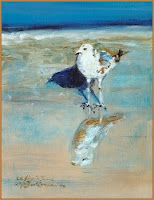News Release
Contacts: (download this news release)
Victor Samuelsen, Fantslake@aol.com
William Barth Osmundsen, billosmundsen@aol.com
Subject: Voyage of the Fox, 115 years ago
This year, June 6th, 2011, marks the 115th anniversary of the departure from New York, which began the 2 Month saga known as the Voyage of the FOX.
It was the first transatlantic crossing, by oar in an open 18 foot rowboat named FOX. The crossing was completed in the record time of 55 days, a record that wasn't broken until last year but only then by 4 men in a modern covered rowing craft..
In 1896 two extraordinary Norwegian-Americans ventured out on to the vast Atlantic Ocean in a 'surfboat'. They weren't escaping from a sinking ship or dory men from a Gloucester Schooner but had taken up the days challenge for a transoceanic crossing by oar. They did not carry any sail or powered propulsion of any kind other than two sets of strong arms and three sets of oars.
George Harbo was from Sandefjord, Norway, age 32 and
Frank Samuelsen, from Farsund, Norway age 26.
Both men despite their young ages had plenty of experience at sea. George had been trained as a Pilot and Navigator and had been in the Merchant Marine. Frank had spent 6 years in the Merchant Marine and was promoted quickly up the chain of command to boson’s mate.
After years at sea, the men met in the New York area, George settling in Brooklyn and Frank on the New Jersey shore after Clamming for a time, they took up the challenge, for a $10,000. purse to row the Atlantic.
Learn more…
Web Site:
Bronzesea.org
See pages referencing
The Voyage of the Fox
LINKS
FOX SCULPTURE
NewYorkTimesonFox
Police Gazette on FOX
RipleyBelieveItorNot
 'A time before 9/11"
'A time before 9/11"








